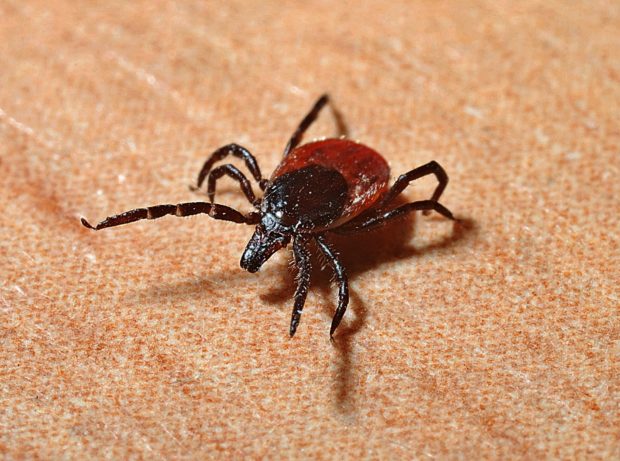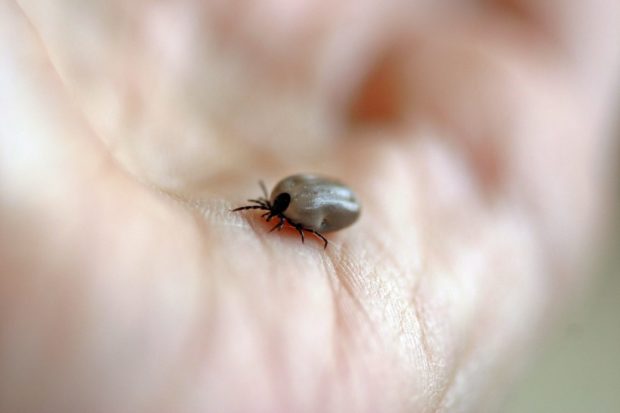Summer is in full swing and whilst you’re basking in the sun and enjoying the outdoors, it’s important to note that the threat of ticks isn’t so far off. Aside from being a less than attractive site, ticks can harbor a lot of crisis and bacteria that can result in a nasty tick-borne illness.
If you hear tick-borne illness and the first thing that comes to your mind is Lyme disease, then you wouldn’t be wrong. According to the Centers for Disease Control and Prevention (CDC), Lyme is the most commonly diagnosed tick-borne illness in the United States with an estimated 300,000 diagnosed cases of Lyme disease each year. That said, Lyme disease isn’t the only illness that you should be worried about contracting from ticks.
In April of this year, the CDC revealed that tick populations are on the rise (1). With that said, it’s important to inform yourself about tick-borne illnesses and where they’re most common. In doing so, you’ll be able to protect yourself from contracting any of the tick-related diseases.
7 Illnesses That Ticks Can Cause
1. Babesiosis
Babesiosis is caused by the Babesia parasite, which attacks the red blood cells. The tick that carries the Babesia parasite is also responsible for Lyme disease thus the two illnesses often occur at the same time. In fact, a study published in the journal Trends in Parasitology found that a fifth of people diagnosed with Lyme was also infected with Babesia. Interestingly, babesiosis can also pass via contaminated blood transfusions, and this includes the transmission from an infected pregnant woman to her fetus.
Once the tick attaches itself to small mammals, it transmits the Babesia parasite to the rodents’ blood. Other strains of the Babesia parasite can infect dogs, goats, horses, and cattle. Once done, it will fall off and wait for a new patch of open skin. Unfortunately, as the tick is so small, it would be hard for you to notice it on your shoe or sock without a thorough search.
What are the symptoms of babesiosis?
According to the CDC, many people who have babesiosis may never show any symptoms (2). However, there are some that deal with flu-like symptoms.
For one, an attack on red blood cells by the parasite may often cause abdominal pain. Additional symptoms include:
- high fever

- severe headaches
- nausea
- Yellowing of your skin and eyes
Furthermore, if left undiagnosed, babesiosis can be severe and cause a number of complications that include;
- low blood pressure
- Liver problems
- hemolytic anemia. This is when the body is unable to produce red blood cells faster than they’re being destroyed.
- kidney failure and
- heart failure
Are you at risk?
According to the CDC, if you live in the Northeast or upper Midwest (including places like New England, New York, New Jersey, Wisconsin, and Minnesota), you are at an increased risk of babesiosis (3). You are also at greater risk if you happen to have no spleen or a weakened immune system.
2. Borrelia miyamotoi disease
Borrelia miyamotoi disease is caused by the bacteria Borrelia miyamotoi, which is in the same group of bacteria that causes Lyme disease. Moreover, the ticks that carry the bacteria are black-legged (deer) ticks.
Whilst there have been fewer than 60 documented cases of people battling Borrelia miyamotoi disease, the number is likely to rise due to the simple fact that Lyme disease rates are also rising.
What are the symptoms of B. miyamotoi?
Similar to babesiosis, B. miyamotoi causes flu-like symptoms between 12 and 16 days after a tick bite. These symptoms include fever, chills, sweats, headaches, joint pain, confusion, abdominal pain, and fatigue.
How do you diagnose and treat it?
Unfortunately, few clinical laboratories currently offer blood tests that are specific for B. miyamotoi diagnosis. However, doctors will be able to evaluate your symptoms and run other lab tests in an effort to find specific antibodies in your system (4).
Once identified, doctors are more likely to prescribe two to four weeks of the antibiotic doxycycline.
Are you at risk?
You are at a higher risk of Borrelia miyamotoi if you live in the upper Midwest, the Northeast, or any mid-Atlantic state (5). Additionally, you’ll need to keep a close eye out for the months of July and August.
3. Colorado tick fever
Colorado tick fever is caused by a bite from an infected Dermacentor andersoni wood tick, which is commonly referred to as the Rocky Mountain wood tick.
Symptoms can begin three to six days after the tick bite. The fever in Colorado tick fever is biphasic fever. This means that the fever you battle with after the tick bite goes away after a few days only to return several days later for a shorter period of time. Other symptoms associated with the disease include:
- severe headaches
- light sensitivity
- muscle aches
- skin tenderness
- loss of appetite
- nausea
- Vomiting
- abdominal pain
- weakness and fatigue
- A faint rash
Lastly, while Colorado tick fever rarely causes complications, there are some cases whereby the disease can lead to inflammation in the nervous system.
 How do you diagnose and treat it?
How do you diagnose and treat it?
According to the CDC, in order to diagnose Colorado tick fever, your doctor will likely run lab tests in order to examine your blood (6).
These tests can determine whether antibodies to the Colorado tick fever virus are present in the blood. Another test is in the form of a blood test and it helps doctors determine the exact cause of symptoms. Additionally, as Colorado tick fever can affect the liver, there is a test that evaluates how well the liver is working.
In order to treat the disease, you’ll just have to get plenty of rest and stay hydrated. Essentially, you’ll have to wait for symptoms to go away on their own (they usually do so within 10 days). However, if symptoms persist and you find your condition worsening, you may have to either be treated with pain relief medications. You may also have to be hospitalized in order to reduce your symptoms.
Are you at risk?
Colorado tick fever is more prevalent in the state of, you guessed it, Colorado. However, the CDC has noted that this occurs in areas that are in the western United States and western Canada and are 4,000 to 10,000 feet above sea level. If you live in any of these areas, make sure that you’re adequately protected during the months of April, May, June, and July (7).
4. Ehrlichiosis
Ehrlichiosis is either caused by you getting bitten by an infected lone star tick or by deer ticks.
Symptoms, like the previously mentioned illnesses, are very flu-like and typically begin between 7 and 14 days after the tick bite. These include headaches, nausea, diarrhea, fever, and muscle aches. Additional symptoms include two types of rashes, with one being small, pin-sized spots and the other being flat and red.
How do you diagnose and treat it?
Diagnosing ehrlichiosis is done through blood testing. Following a positive diagnosis, antibiotics are often the route chosen to treat the illness. One is likely to notice a significant improvement in their health within 48 hours after beginning their treatment. Moreover, they may experience a full recovery within three weeks.
That said, it’s important to begin treatment as soon as possible as ehrlichiosis can cause serious long-term health complications such as respiratory failure, heart failure, falling into a coma, organ failure, bleeding problems, seizures, and even death in rare cases.
Are you at risk?
As mentioned, the lone star tick and the deer tick are responsible for transmitting ehrlichiosis. These ticks are usually found in Southeastern and South-central parts of the United States as well as the East Coast. Also, infections hit their peak during the months of June and July.
5. Powassan virus
The Powassan virus occurs when one is bitten by an Ixodes scapularis (deer tick). Other types of ticks associated with the Powassan virus are believed to be rarer and tend to bite rodents instead.
An interesting, yet alarming aspect of the Powassan virus is the fact that the infection, unlike other tick illnesses, can take a mere 15 minutes to occur (8).
What are the symptoms of the Powassan virus?
Powassan virus infection can be mild in some people, thus they are unlikely to experience any symptoms. However, if symptoms do occur, they are often flu-like and typically appear from about a week to a month after the bite takes place. The most common symptoms include fever, headache, seizures, dizziness, confusion, and nausea.

Unfortunately, the Powassan virus can progress and affect the nervous system. This can then cause encephalitis, which is inflammation of the brain, and meningitis, which is inflammation of the membranes that surround the brain and spinal cord. These two diseases may cause serious neurological damage.
How do you diagnose and treat it?
Doctors may perform a blood test or a spinal fluid test to determine if you have the Powassan virus. In regards to treating the condition, there is, unfortunately, no vaccines or medications that can help treat the Powassan virus. If your infections are mild, your doctor will do their best to help mitigate your symptoms. Unfortunately, severe symptoms will require hospitalization so that the doctors can offer you support that will help address the brain swelling.
Are you at risk?
Powassan virus is typically found in the Northeast and Great Lakes regions of the United States, Canada, and even Russia. In the United States, at least 75 of the inhabitants have been infected over the past few years.
6. Rocky Mountain spotted fever
Rocky Mountain spotted fever is transmitted through the bite of a tick that’s been infected with the bacterium, Rickettsia rickettsii. The main ticks that carry Rocky Mountain spotted fever are the American dog tick (Dermacentar variablis), the Rocky Mountain wood tick (Dermacentor andersoni), and the brown dog tick (Rhipicephalus sanguineus).
Over the past few years, the incidences of Rocky Mountain spotted fever has increased with the current number of cases coming down to 2,000 cases every year. What’s more, dogs are susceptible to Rocky Mountain spotted fever. Thus, an infected tick can make its way from your dog’s body to your own.
What are the symptoms of Rocky Mountain spotted fever?
Symptoms of Rocky Mountain spotted fever, which typically begins between 2 and 14 days after the tick bite, include a rash, high fever, chills, nausea, fatigue, poor appetite, and abdominal pain.
While the symptoms of Rocky Mountain spotted fever are similar to other tick-borne illnesses, doctors often look for a rash to help support their diagnosis. Whilst not everyone will develop the rash, those who do will see it appear a few days after the first symptoms. It’s usually found on the wrists, ankles, palms, and soles of the feet before spreading towards the torso. The rash can often be reddish or purple in color.
If left undiagnosed and untreated, Rocky Mountain spotted fever can lead to a number of serious health complications that include;
- coma
- brain swelling
- inflammation of the heart
- inflammation of the lungs
- kidney failure
- hearing loss
- muscle weakness
- partial paralysis of one side of the body and even
- death
How do you diagnose and treat it?
To treat Rocky Mountain spotted fever, the CDC recommends the use of an oral antibiotic known as doxycycline. The goal is to treat the disorder as soon as possible, preferably within the fires five days of infection, as any delay may lead to the severe health complications mentioned above.
If there is any delay in treatment, you may find yourself in the hospital. Here, you will likely receive intravenous fluids.
Are you at risk?
Aside from owning a dog or spending a lot of time with dogs, you are at an increased risk of getting Rocky Mountain spotted fever if you live in any of the following states:

- North Carolina
- Tennessee
- Missouri
- Arkansas
- Oklahoma
- Alabama
- Delaware
- Illinois
- Kentucky
- Mississippi
- Nebraska
- Virginia
Also, while the infection can occur at any time of the year, it is more common during May, June, July, and August.
7. Tularemia
Tularemia usually infects rabbits, squirrels, and wild rodents. Wood and lone star ticks are responsible for transmitting the Francisella tularensis bacteria into the body. However, that’s not the only way you can develop tularemia. You can get tularemia infection from breathing in dust that contains bacteria, whilst gardening or taking a long, hike.
That said, there are different strains of tularemia whose classification is based on the bacterium’s route of entry into the body.
What are the symptoms of Tularemia?
Symptoms of tularemia depend on how bacteria enter the body.
If transmitted through a tick bite, the infection is referred to as ulceroglandular tularemia. Symptoms associated with the illness include a skin ulcer at the site of the bite, swollen lymph nodes near the armpit or groin, severe headaches, fever, chills, and fatigue (10).
Pneumonic tularemia occurs when the Francisella tularensis bacteria is inhaled. Symptoms can include a dry cough, difficulty breathing, a high fever, and chest pain.
How do you diagnose and treat it?
Laboratory tests intended to identify the bacteria are what doctors use when looking to diagnose any form of tularemia. Following this, they are more likely to prescribed antibiotics, including doxycycline, as a form of treatment.
Are you at risk?
If you work closely with animals or animal carcasses, you are at an increased risk of tularemia. That said, it’s important to always wear gloves and goggles when handling any animal and to wash your hands carefully after the fact.
How can I protect myself from ticks?
If you want to protect yourself against ticks, it’s best to avoid grassy, wooded areas where ticks are most likely to hide. However, if you’re an avid hiker or camper, there are other ways in which you can protect yourself.
![plant fall [longevity live]](https://longevitylive.com/wp-content/uploads/2019/07/beautiful-blue-flowers-child-193035-620x413.jpg)
- Always wear long pants when outdoors.
- Try to stay on already-made trails instead of walking through grassy areas.
- Never leave the house without wearing a repellant that contains ingredients like DEET, picaridin, IR3535, oil of lemon eucalyptus, para-menthane-diol (PMD), or 2-undecanone. Products that you can use include Ben’s 30% Deet Insect Repellent Spray.
- Consider treating your clothes, shoes, and camping gear with products that contain 0.5 percent of the insecticide permethrin, such as the Sawyer Products Premium Permethrin Clothing Insect Repellent.
- Always do a tick check once you get home – be sure to look over your whole body, including easy-to-miss spots like your elbows, ears, along your hairline, the backs of your knees, and even inside your bellybutton.
- Check your pets as well.
- Shower within two hours of being outdoors to remove unattached ticks.
- Wash your clothes in hot water and run them through the dryer to kill any lingering ticks.
What should I do if I find a tick on my skin?
Firstly, don’t panic. Second, take note of the following steps that will help you effectively, and safely, remove the tick.
- Grab a pair of fine-tipped tweezers.
- Wear latex gloves or place a paper towel or tissue over your fingers.
- Grab the tick with the tweezers as close to your skin as possible and pull up in a steady motion.
- Remove it carefully and very slowly, making sure to grab it as close to the head as possible.
- Using a twisting or jerking motion may cause the tick to break. If this happens, it will be very difficult to remove the rest of the body.
- Wash your hands and the bite mark with soap and water.
- Put the tick in a plastic bag in your freezer, making note of the date. If you become ill, the tick can help your doctor make a diagnosis more easily.



 How do you diagnose and treat it?
How do you diagnose and treat it?![women [longevity live]](https://longevitylive.com/wp-content/uploads/2020/01/photo-of-women-walking-down-the-street-1116984-100x100.jpg)










